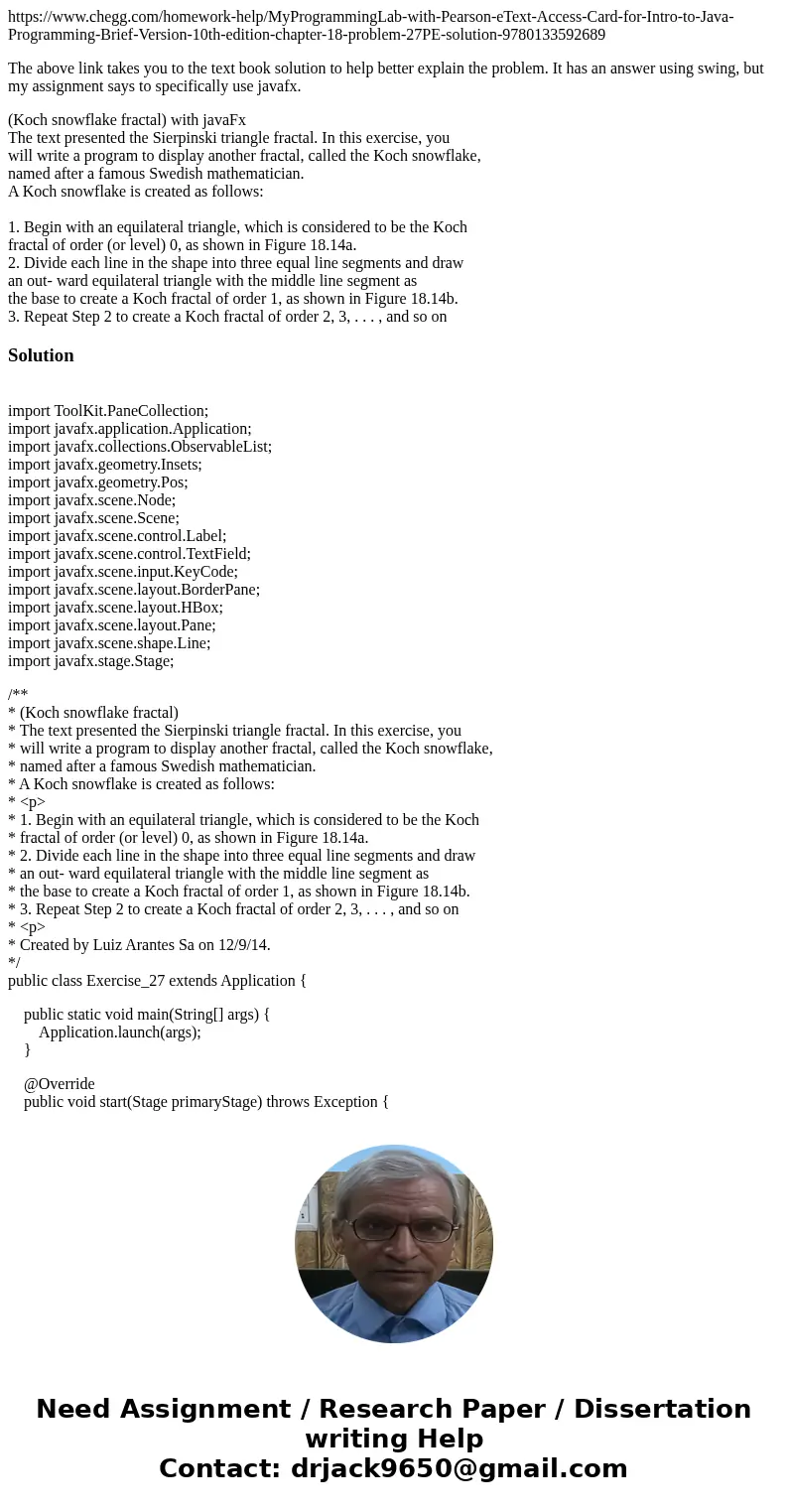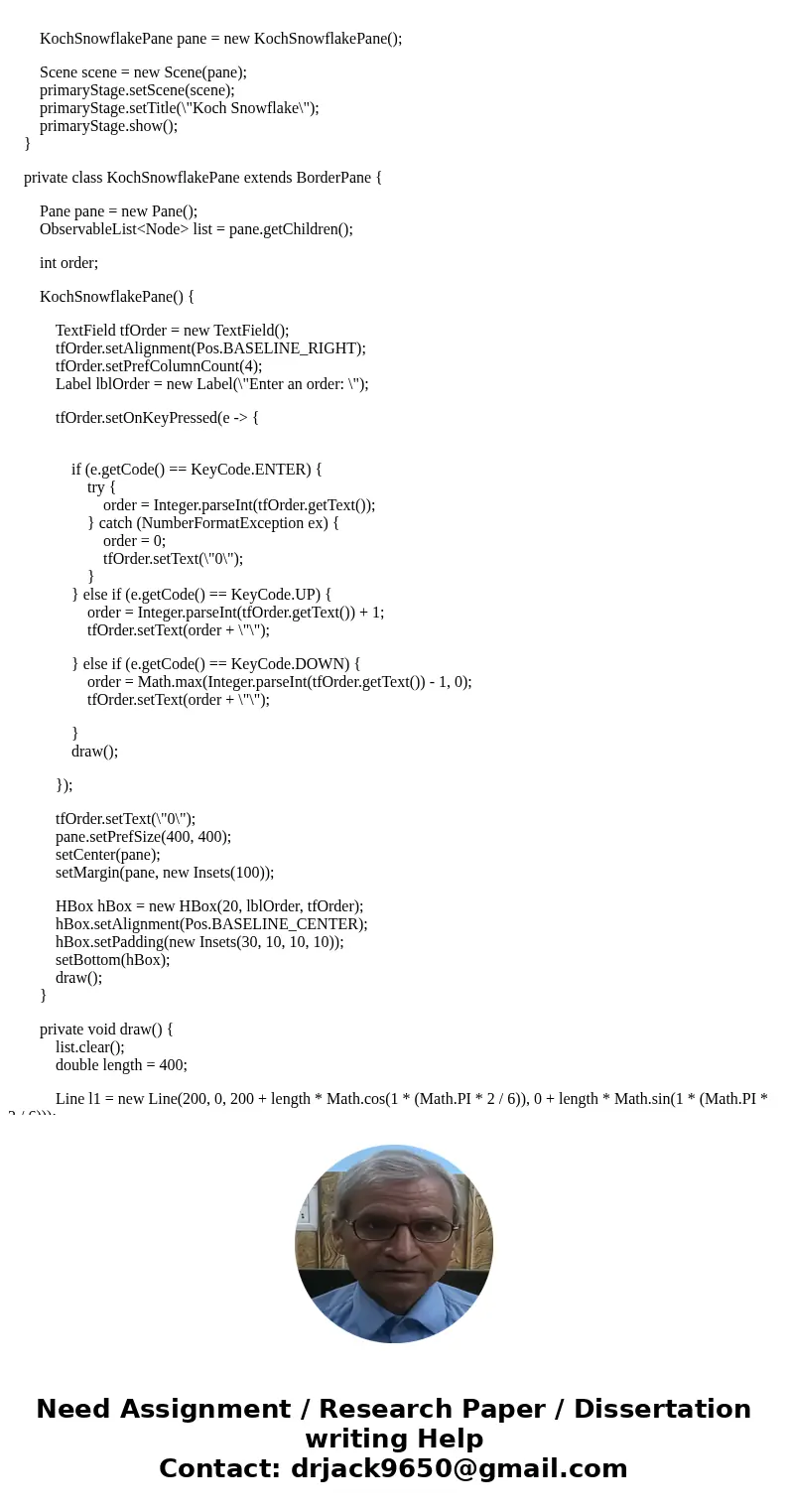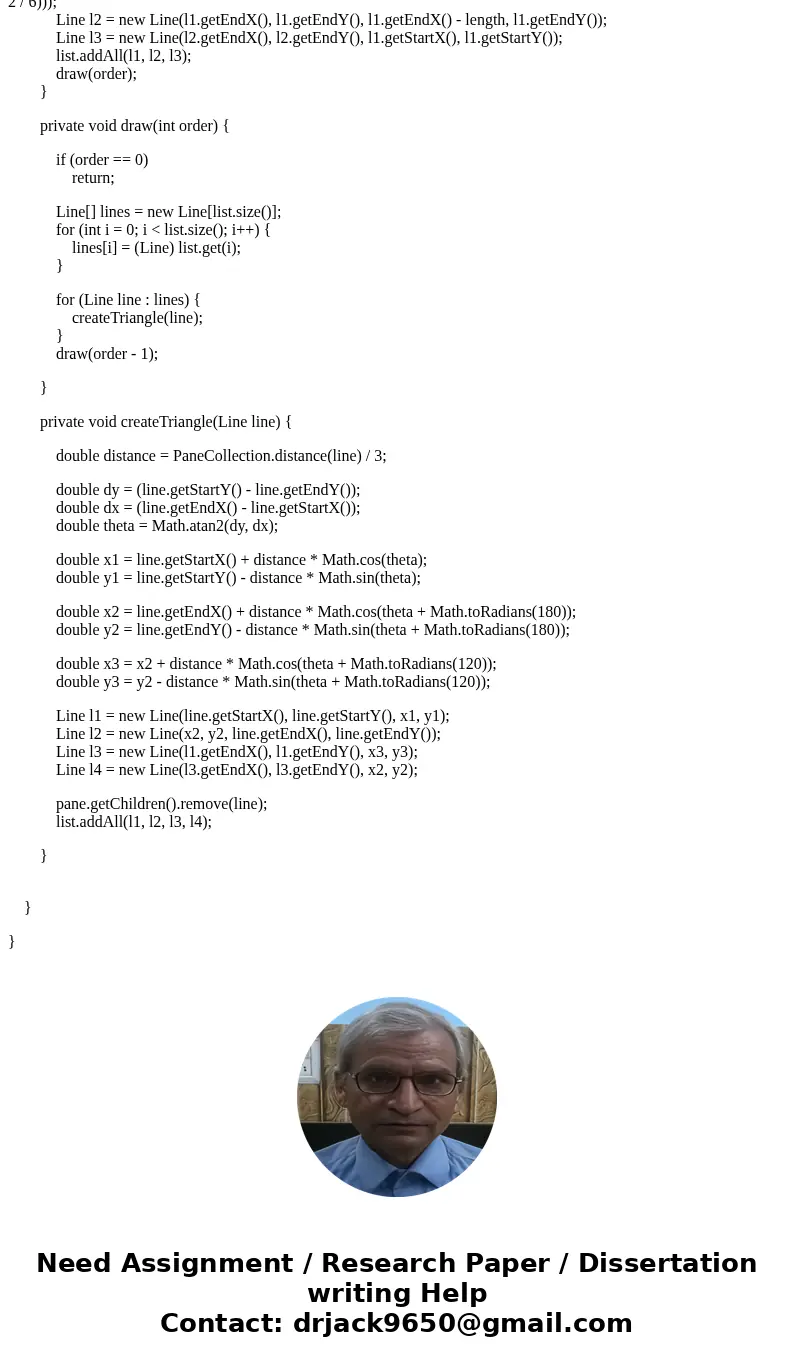httpswwwcheggcomhomeworkhelpMyProgrammingLabwithPearsoneText
https://www.chegg.com/homework-help/MyProgrammingLab-with-Pearson-eText-Access-Card-for-Intro-to-Java-Programming-Brief-Version-10th-edition-chapter-18-problem-27PE-solution-9780133592689
The above link takes you to the text book solution to help better explain the problem. It has an answer using swing, but my assignment says to specifically use javafx.
(Koch snowflake fractal) with javaFx
The text presented the Sierpinski triangle fractal. In this exercise, you
will write a program to display another fractal, called the Koch snowflake,
named after a famous Swedish mathematician.
A Koch snowflake is created as follows:
1. Begin with an equilateral triangle, which is considered to be the Koch
fractal of order (or level) 0, as shown in Figure 18.14a.
2. Divide each line in the shape into three equal line segments and draw
an out- ward equilateral triangle with the middle line segment as
the base to create a Koch fractal of order 1, as shown in Figure 18.14b.
3. Repeat Step 2 to create a Koch fractal of order 2, 3, . . . , and so on
Solution
import ToolKit.PaneCollection;
import javafx.application.Application;
import javafx.collections.ObservableList;
import javafx.geometry.Insets;
import javafx.geometry.Pos;
import javafx.scene.Node;
import javafx.scene.Scene;
import javafx.scene.control.Label;
import javafx.scene.control.TextField;
import javafx.scene.input.KeyCode;
import javafx.scene.layout.BorderPane;
import javafx.scene.layout.HBox;
import javafx.scene.layout.Pane;
import javafx.scene.shape.Line;
import javafx.stage.Stage;
/**
* (Koch snowflake fractal)
* The text presented the Sierpinski triangle fractal. In this exercise, you
* will write a program to display another fractal, called the Koch snowflake,
* named after a famous Swedish mathematician.
* A Koch snowflake is created as follows:
* <p>
* 1. Begin with an equilateral triangle, which is considered to be the Koch
* fractal of order (or level) 0, as shown in Figure 18.14a.
* 2. Divide each line in the shape into three equal line segments and draw
* an out- ward equilateral triangle with the middle line segment as
* the base to create a Koch fractal of order 1, as shown in Figure 18.14b.
* 3. Repeat Step 2 to create a Koch fractal of order 2, 3, . . . , and so on
* <p>
* Created by Luiz Arantes Sa on 12/9/14.
*/
public class Exercise_27 extends Application {
public static void main(String[] args) {
Application.launch(args);
}
@Override
public void start(Stage primaryStage) throws Exception {
KochSnowflakePane pane = new KochSnowflakePane();
Scene scene = new Scene(pane);
primaryStage.setScene(scene);
primaryStage.setTitle(\"Koch Snowflake\");
primaryStage.show();
}
private class KochSnowflakePane extends BorderPane {
Pane pane = new Pane();
ObservableList<Node> list = pane.getChildren();
int order;
KochSnowflakePane() {
TextField tfOrder = new TextField();
tfOrder.setAlignment(Pos.BASELINE_RIGHT);
tfOrder.setPrefColumnCount(4);
Label lblOrder = new Label(\"Enter an order: \");
tfOrder.setOnKeyPressed(e -> {
if (e.getCode() == KeyCode.ENTER) {
try {
order = Integer.parseInt(tfOrder.getText());
} catch (NumberFormatException ex) {
order = 0;
tfOrder.setText(\"0\");
}
} else if (e.getCode() == KeyCode.UP) {
order = Integer.parseInt(tfOrder.getText()) + 1;
tfOrder.setText(order + \"\");
} else if (e.getCode() == KeyCode.DOWN) {
order = Math.max(Integer.parseInt(tfOrder.getText()) - 1, 0);
tfOrder.setText(order + \"\");
}
draw();
});
tfOrder.setText(\"0\");
pane.setPrefSize(400, 400);
setCenter(pane);
setMargin(pane, new Insets(100));
HBox hBox = new HBox(20, lblOrder, tfOrder);
hBox.setAlignment(Pos.BASELINE_CENTER);
hBox.setPadding(new Insets(30, 10, 10, 10));
setBottom(hBox);
draw();
}
private void draw() {
list.clear();
double length = 400;
Line l1 = new Line(200, 0, 200 + length * Math.cos(1 * (Math.PI * 2 / 6)), 0 + length * Math.sin(1 * (Math.PI * 2 / 6)));
Line l2 = new Line(l1.getEndX(), l1.getEndY(), l1.getEndX() - length, l1.getEndY());
Line l3 = new Line(l2.getEndX(), l2.getEndY(), l1.getStartX(), l1.getStartY());
list.addAll(l1, l2, l3);
draw(order);
}
private void draw(int order) {
if (order == 0)
return;
Line[] lines = new Line[list.size()];
for (int i = 0; i < list.size(); i++) {
lines[i] = (Line) list.get(i);
}
for (Line line : lines) {
createTriangle(line);
}
draw(order - 1);
}
private void createTriangle(Line line) {
double distance = PaneCollection.distance(line) / 3;
double dy = (line.getStartY() - line.getEndY());
double dx = (line.getEndX() - line.getStartX());
double theta = Math.atan2(dy, dx);
double x1 = line.getStartX() + distance * Math.cos(theta);
double y1 = line.getStartY() - distance * Math.sin(theta);
double x2 = line.getEndX() + distance * Math.cos(theta + Math.toRadians(180));
double y2 = line.getEndY() - distance * Math.sin(theta + Math.toRadians(180));
double x3 = x2 + distance * Math.cos(theta + Math.toRadians(120));
double y3 = y2 - distance * Math.sin(theta + Math.toRadians(120));
Line l1 = new Line(line.getStartX(), line.getStartY(), x1, y1);
Line l2 = new Line(x2, y2, line.getEndX(), line.getEndY());
Line l3 = new Line(l1.getEndX(), l1.getEndY(), x3, y3);
Line l4 = new Line(l3.getEndX(), l3.getEndY(), x2, y2);
pane.getChildren().remove(line);
list.addAll(l1, l2, l3, l4);
}
}
}



 Homework Sourse
Homework Sourse